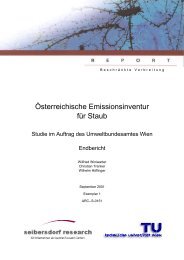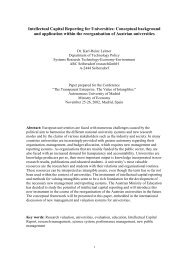ALPMON FINAL REPORT - ARC systems research
ALPMON FINAL REPORT - ARC systems research
ALPMON FINAL REPORT - ARC systems research
You also want an ePaper? Increase the reach of your titles
YUMPU automatically turns print PDFs into web optimized ePapers that Google loves.
Contract ENV4-CT96-0359 <strong>ALPMON</strong><br />
100.000 derived from geocoded Landsat TM or SPOT HRV images. The nomenclature for<br />
interpretation consists of three hierarchical levels, of which the third one comprises 44 land-cover<br />
classes (Table 10). The outcome of the project are digital vector layers representing borders of<br />
homogeneous land-cover units.<br />
In 1994 a related land-cover project was started at the Austrian Research Centre Seibersdorf. The<br />
image data used in this project comprise 12 Landsat TM scenes acquired between July and<br />
September 1991. In contrast to the methodology of CORINE it concentrated on the semi-automatic<br />
production of a land-use map of Austria. In order to allow a comparison between this land-use map<br />
and the CORINE data set, the CORINE nomenclature was used in the project.<br />
In general it can be stated that automatic procedures are a valuable alternative to visual interpretation.<br />
Major conclusions to be drawn from the comparison are:<br />
1. The spatial resolution of Landsat TM images limits the recognition of certain classes (in the visual<br />
interpretation approach these classes were recognised by means of ancillary data)<br />
2. per pixel classification and subsequent spatial post-classification of Landsat TM images limits the<br />
precise delineation of certain objects, or even suppresses narrow objects.<br />
3. adequate pre-processing of digital images, such as topographic correction, improves the<br />
classification accuracy in mountainous areas significantly.<br />
This leads to the basic requirement of image data with a higher geometrical resolution in order to solve<br />
for conclusions 1 and 2. At the same time conclusion 3 will still be valid as long as the image data are<br />
digital. Within <strong>ALPMON</strong> these requirements will be fulfilled, as high spatial resolution image data will be<br />
used for analysis and appropriate pre-processing will be applied. It is therefore expected that for the<br />
<strong>ALPMON</strong> test areas level III classes will be detectable.<br />
A particular interest of the customer lies in the high alpine regions which are considered the most<br />
crucial areas for visual interpretation. This includes above all the 'Forests and semi-natural areas'<br />
classes of the CORINE nomenclature. A clear distinction of bare rock, sparsely vegetated areas,<br />
natural grassland and different forested areas is of major interest for the customer. In addition<br />
separation of dwarf-pines from other coniferous forests would significantly improve the available<br />
information.<br />
The requirement of the customer is to get land cover maps of the test sites according to level III of the<br />
CORINE nomenclature. If it is possible to increase the thematic subdivision, a level IV nomenclature<br />
will be established. The major motivation of the customer is to estimate the feasibility of an automatic<br />
derivation of CORINE land-cover maps from high resolution satellite imagery for updating the existing<br />
CORINE data base. In order to fulfil this task image data with a high spatial resolution are<br />
indispensable, thus increasing the costs for data acquisition. On the other hand these additional costs<br />
might be compensated by a significant reduction of processing time compared to the visual<br />
interpretation. Therefore the interest of the customer includes an estimation of time and costs of the<br />
<strong>ALPMON</strong> approach with regard to the derivation of CORINE land-cover maps.<br />
2.1.3 Requirements Fulfilled by <strong>ALPMON</strong><br />
Due to the diverse customers and their to some extent very different requirements it would not be<br />
useful to compile a complete list of the parameters to be derived from remote sensing and additional<br />
sources. However, an aggregated list of parameters, which indicates the parameters required for each<br />
feasibility study and test site respectively, is given in Annex 3. This list represents the parameters<br />
which were required by most of the customers and which are also relevant for the Alpine Monitoring<br />
System. The parameters merely distinguish in their further subdivision into subclasses such as number<br />
of age classes or crown closure classes within the forests and their recording accuracy. The<br />
hierarchical nomenclature developed in WP3 (Set up and Harmonisation) can be used as a link<br />
between the different customer requirements and the Alpine Convention. Additionally, a list of classes<br />
(Table 1) was suggested as a minimum standard for all applications within <strong>ALPMON</strong>. That means,<br />
each partner tried to delineate at least these classes, supplemented by the classes relevant for the<br />
respective application. Some classes have been taken into consideration because they are relevant for<br />
the Alpine Convention (AC), other classes due to their ecological importance.<br />
Table 2 shows the benefits of the national applications to the General Obligations defined in Article 2 of<br />
the Alpine Convention. All subsequent tasks were matched with the requirements investigated within<br />
this work package.<br />
JR, RSDE, ALU, LMU, Seibersdorf, WSL 15




